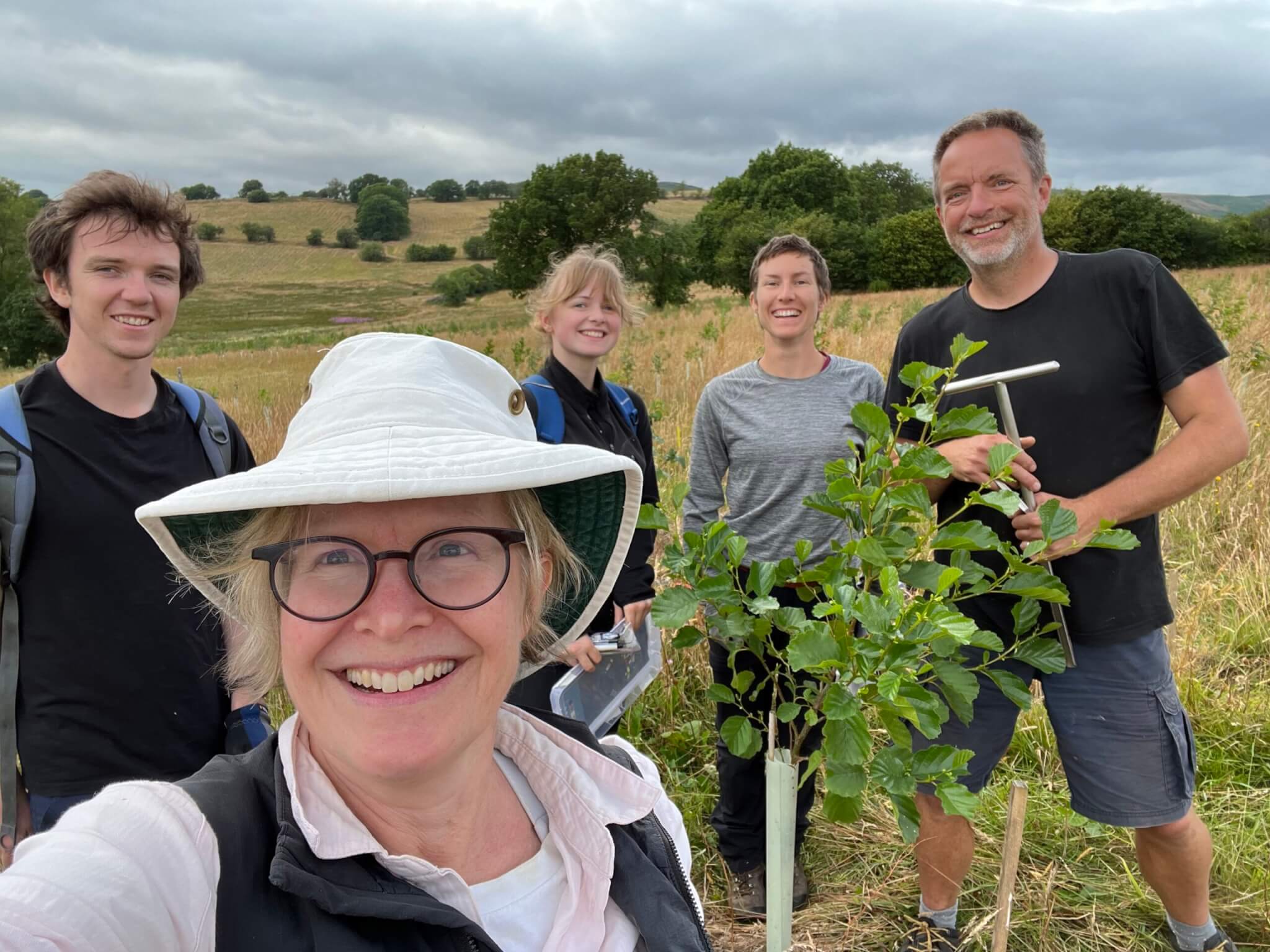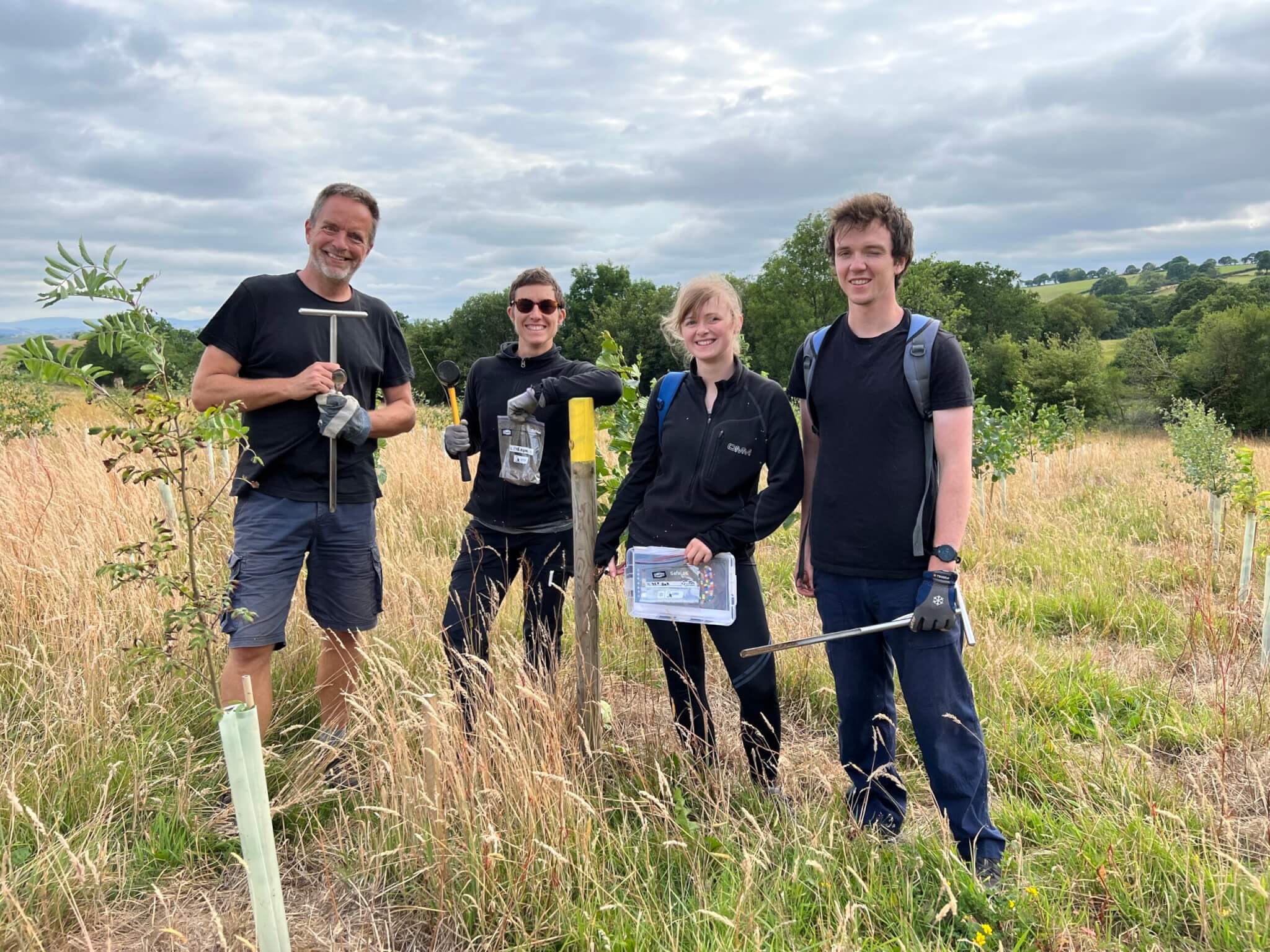Lab technician Laura Gobelius visited the largest existing soil fungi inoculation experiment site to date. Three days in the field filled with environmental and technical challenges – and the fun of collaborating with scientists all over the world.
It is a magical sight: lush, green, rolling hills, Victorian cottages tucked away off winding, narrow streets, and flocks of sheep everywhere you look around. In a place like this, one will inevitably get the feeling that special things must be underway. I was on my way to Glandwr forest deep in the heart of Wales, and wonderstruck by the gorgeous views from my seat behind the steering wheel (in unfamiliar left-handed traffic; an adventure in itself). I would have loved to stop and enjoy the sunset, but I was even more eager to finally arrive at our research site.
Sequestering carbon on a massive scale
The Glandwr forest, spanning an area of 28 acres, is a carbon sequestration and restoration project of massive, unprecedented scale. Set close to the small town of Llandovery, more than 75,000 trees are growing into a broadleaf and a coniferous forest, just like those Wales used to be covered with (before sheep took over the landscape). Of these trees, 25,000 are part of a scientifically monitored carbon sequestration study led by The Carbon Community using the intact soil microbiome of neighbouring forests to enhance tree growth and carbon capture. My mission for Crowther Lab: sampling the soil microbiome of 1400 of those trees so that we may better understand the processes of soil inoculation for forest growth.
Soil fungi inoculation for forest growth
What does the soil microbiome have to do with tree growth and carbon capture? Belowground, trees form a mutualistic bond with mycorrhizal fungi at their roots to increase access to soil nutrients. In exchange fungi receive carbon from trees. In existing, natural forests, these bonds form on their own. But when trying to establish a new forest on (potentially) degraded land, or former pasture or agricultural land, newly planted seedlings often find themselves alone, missing their little helpers from the forest microbiome. As a consequence, many trees find it hard to establish themselves, and eventually die. However, recent studies have shown that restoring forests can be more successful when the tree seedlings are inoculated with the soil microbiome from a healthy and established forest nearby.
The Glandwr forest is the first experiment that puts this knowledge into practice at such a large scale. It is an immense collaborative effort shared by several universities and highly motivated scientists dedicated to restoration and stopping climate change. I feel lucky to be part of it!
Click on the slider to learn more about each image (all photos © The Carbon Community)
Out of the lab and into the field
Together with a group of dedicated volunteers, I sampled eight plots with distinct experimental treatments each to examine the effects of soil microbiome inoculation on seven different tree species, among others sitka spruces, oak and alder trees. As luck would have it, we were often working under the blazing sun of Europe’s 2022 heat wave (the tree saplings are still too small to provide shade). But despite a lot of sweating, horsefly bites and grass allergies, we had a lot of fun!
As a lab technician working mostly inside, I love the change fieldwork presents with all its challenges, unexpected adventures (like your car breaking down and you having to jumpstart it in the middle of nowhere) and time spent outdoors. What’s more, being able to share these experiences with others who have the same passion for our environment and science makes this job incomparable to any other. I was also thrilled by the cooperation and hospitality of all the motivated helpers: without them my mission would have been impossible.
Preparing future research
Thanks to our collective labour, we managed to sample all 1400 trees in just three days despite needing to take several breaks due to heat and a thunderstorm. Back in Zurich, I successfully overcame the last challenge: getting my two suitcases filled with 24kg of soil smoothly through customs. Together with measurements of the size and growth increment of these trees, these samples will enable us to measure the effect of microbiome inoculation on forest restoration. I am excited to soon start extracting fungal DNA from each of them to see which fungi are really making this forest grow.
In the coming decades, the Glandwr forest will continue to be closely monitored. I hope that it will serve as a role model for restoration practice, as well as a sign of hope in the fight against climate change by bringing many dedicated and inspiring people together. A project that not only helps a forest grow – but also helps a global community and science to grow.
The Carbon Community in Wales is regularly organising volunteering events to help with the measurements necessary with the study: https://www.eventbrite.com/cc/community-science-volunteering-at-glandwr-forest-811459
The Bergwaldprojekt is organising volunteering for nature restoration in Switzerland and Germany, free to join and a lot of fun: https://bergwaldprojekt.ch/aktiv-werden/einzelpersonen/









